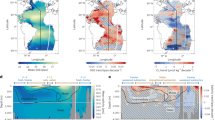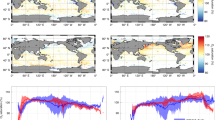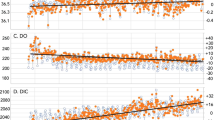Abstract
Direct observations indicate that the global ocean oxygen inventory is decreasing. Climate models consistently confirm this decline and predict continuing and accelerating ocean deoxygenation. However, current models (1) do not reproduce observed patterns for oxygen changes in the ocean’s thermocline; (2) underestimate the temporal variability of oxygen concentrations and air–sea fluxes inferred from time-series observations; and (3) generally simulate only about half the oceanic oxygen loss inferred from observations. We here review current knowledge about the mechanisms and drivers of oxygen changes and their variation with region and depth over the world’s oceans. Warming is considered a major driver: in part directly, via solubility effects, and in part indirectly, via changes in circulation, mixing and oxygen respiration. While solubility effects have been quantified and found to dominate deoxygenation near the surface, a quantitative understanding of contributions from other mechanisms is still lacking. Current models may underestimate deoxygenation because of unresolved transport processes, unaccounted for variations in respiratory oxygen demand, or missing biogeochemical feedbacks. Dedicated observational programmes are required to better constrain biological and physical processes and their representation in models to improve our understanding and predictions of patterns and intensity of future oxygen change.
This is a preview of subscription content, access via your institution
Access options
Access Nature and 54 other Nature Portfolio journals
Get Nature+, our best-value online-access subscription
$29.99 / 30 days
cancel any time
Subscribe to this journal
Receive 12 print issues and online access
$259.00 per year
only $21.58 per issue
Buy this article
- Purchase on Springer Link
- Instant access to full article PDF
Prices may be subject to local taxes which are calculated during checkout



Similar content being viewed by others
References
Schmidtko, S., Stramma, L. & Visbeck, M. Decline in global oceanic oxygen content during the past five decades. Nature 542, 335–339 (2017).
Helm, K. P., Bindoff, N. L. & Church, J. A. Observed decreases in oxygen content of the global ocean. Geophys. Res. Lett. 38, L23602 (2011).
Ito, T., Minobe, A., Long, M. C. & Deutsch, C. Upper ocean O2 trends: 1958–2015. Geophys. Res. Lett. 44, 4214–4223 (2017).
Bopp, L. et al. Multiple stressors of ocean ecosystems in the 21st century: projections with CMIP5 models. Biogeosciences 10, 6225–6245 (2013).
Keeling, R. F., Körtzinger, A. & Gruber, N. Ocean deoxygenation in a warming world. Annu. Rev. Mar. Sci 2, 199–229 (2010).
Praetorius, S. K. et al. North Pacific deglacial hypoxic events linked to abrupt ocean warming. Nature 527, 362–366 (2015).
Watson, A. J. Oceans on the edge of anoxia. Science 354, 1529–1530 (2016).
Watson, A., Lenton, T. & Mills, B. Ocean deoxygenation, the global phosphorus cycle, and the possibility of human-caused large-scale ocean anoxia. Phil. Trans. R. Soc. A 375, 20160318 (2017).
Paulmier, A. & Ruiz-Pino, D. Oxygen minimum zones (OMZs) in the modern ocean. Progr. Oceanogr. 80, 113–128 (2009).
Wyrtki, K. The oxygen minima in relation to ocean circulation. Deep Sea Res. 9, 11–23 (1962).
Karstensen, J., Stramma, L. & Visbeck, M. Oxygen minimum zones in the eastern tropical Atlantic and Pacific oceans. Prog. Oceanogr. 77, 331–350 (2008).
Diaz, R. J. & Rosenberg, R. Spreading dead zones and consequences for marine ecosystems. Science 321, 926–929 (2008).
Kalvelage, T. et al. Nitrogen cycling driven by organic matter export in the South Pacific oxygen minimum zone. Nat. Geosci. 6, 228–234 (2013).
Scholz, F., McManus, J., Mix, A. C., Hensen, C. & Schneider, R. R. The impact of ocean deoxygenation on iron release from continental margin sediments. Nat. Geosci. 7, 433–437 (2014).
Niemeyer, D., Kemena, T. P., Meissner, K. J. & Oschlies, A. A model study of warming-induced phosphorus–oxygen feedbacks in open-ocean oxygen minimum zones on millennial timescales. Earth Syst. Dynam. 8, 357–367 (2017).
Arevalo-Martinez, D. A., Kock, A., Löscher, C. R., Schmitz, R. A. & Bange, H. W. Massive nitrous oxide emissions from the tropical South Pacific Ocean. Nat. Geosci. 8, 530–533 (2015).
Martinez-Rey, J., Bopp, L., Gehlen, M., Tagliabue, A. & Gruber, N. Projections of oceanic N2O emissions in the 21st century using the IPSL Earth system model. Biogeosciences 12, 4133–4148 (2015).
Landolfi, A., Somes, C. J., Koeve, W., Zamora, L. M. & Oschlies, A. Oceanic nitrogen cycling and N2O flux perturbations in the Anthropocene. Global Biogeochem. Cycles 31, 1236–1255 (2017).
Stramma, L., Johnson, G. C., Sprintall, J. & Mohrholz, V. Expanding oxygen-minimum zones in the tropical oceans. Science 320, 655–658 (2008).
Breitburg, D. et al. Declining oxygen in the global ocean and coastal waters. Science 359, eaam7240 (2018).
Oschlies, A. et al. Patterns of deoxygenation - sensitivity to natural and anthropogenic drivers. Phil. Trans. Roy. Soc. A 375, 20160325 (2017).
Long, M. C., Deutsch, C. & Ito, T. Finding forced trends in oceanic oxygen. Global Biogeochem. Cycles 30, 381–397 (2016).
Eddebbar, Y. A. et al. Impacts of ENSO on air-sea oxygen exchange: observations and mechanisms. Global Biogeochem. Cycles 31, 901–921 (2017).
Stramma, L., Oschlies, A. & Schmidtko, S. Mismatch between observed and modeled trends in dissolved upper-ocean oxygen over the last 50 yr. Biogeosciences 9, 4045–4057 (2012).
Frölicher, T. L., Rodgers, K. B., Stock, C. A. & Cheung, W. W. L. Sources of uncertainties in 21st century projections of potential ocean ecosystem stressors. Global Biogeochem. Cycles 30, 1224–1243 (2016).
IPCC Climate Change 2013: The Physical Science Basis (eds Stocker, T. F. et al.) (Cambridge Univ. Press, 2013).
Cabré, A., Marinov, I., Bernardello, R. & Bianchi, D. Oxygen minimum zones in the tropical Pacific across CMIP5 models: mean state differences and climate change trends. Biogeosciences 12, 5429–5454 (2015).
Levin, L. A. Manifestation, drivers, and emergence of open ocean deoxygenation. Annu. Rev. Mar. Sci 10, 229–260 (2018).
Brandt, P. et al. On the role of circulation and mixing in the ventilation of oxygen minimum zones with a focus on the eastern tropical North Atlantic. Biogeosciences 12, 489–512 (2015).
Duteil, O., Schwarzkopf, F. U., Böning, C. W. & Oschlies, A. Major role of the equatorial current system in setting oxygen levels in the eastern tropical Atlantic Ocean: a high-resolution model study. Geophys. Res. Lett. 41, 2033–2040 (2014).
Ridder, N. N. & England, M. H. Sensitivity of ocean oxygenation to variations in tropical zonal wind stress magnitude. Global Biogeochem. Cycles 28, 909–926 (2014).
Liu, C. & Wang, Z. On the response of the global subduction rate to global warming in coupled climate models. Adv. Atmos. Sci. 31, 211 (2014).
Durack, P. J. & Wijffels, S. E. Fifty-year trends in global ocean salinities and their relationship to broad-scale warming. J. Clim. 23, 4342–4362 (2010).
England, M. H. et al. Recent intensification of wind-driven circulation in the Pacific and the ongoing warming hiatus. Nat. Clim. Change 4, 222–227 (2014).
Liu, L. L. & Huang, R. X. The global subduction/obduction rates: their interannual and decadal variability. J. Clim. 25, 1096–1115 (2012).
Stouffer, R. J. et al. Investigating the causes of the thermohaline circulation to past and future climate changes. J. Clim. 19, 1365–1387 (2006).
Brewer, P. G. & Peltzer, E. T. Depth perception: the need to report ocean biogeochemical rates as functions of temperature, not depth. Phil. Trans. R. Soc. A 375, 20160319 (2017).
Oschlies, A., Schulz, K. G., Riebesell, U. & Schmittner, A. Simulated 21st century’s increase in oceanic suboxia by CO2-enhanced biotic carbon export. Global Biogeochem. Cycles 22, GB4008 (2008).
Hofmann, M. & Schellnhuber, H.-J. Oceanic acidification affects marine carbon pump and triggers extended marine oxygen holes. Proc. Natl Acad. Sci. USA 106, 3017–3022 (2009).
Ito, T., Nenes, A., Johnson, M. S., Meskhidze, N. & Deutsch, C. Acceleration of oxygen decline in the tropical Pacific over the past decades by aerosol pollutants. Nat. Geosci. 9, 443–447 (2016).
Segschneider, J. & Bendtsen, J. Temperature-dependent remineralization in a warming ocean increases surface pCO2 through changes in marine ecosystem composition. Global Biogeochem. Cycles 27, 1214–1225 (2013).
Wallmann, K. Phosphorus imbalance in the global ocean? Global Biogeochem. Cycles 24, GB4030 (2010).
Bendtsen, J., Hilligsøe, K. M., Hansen, J. L. S. & Richardson, K. Analysis of remineralisation, lability, temperature sensitivity and structural composition of organic matter from the upper ocean. Progr. Oceanogr. 130, 125–145 (2015).
Bendtsen, J. & Hansen, J. L. S. Effects of global warming on hypoxia in the Baltic Sea–North Sea transition zone. Ecol. Model. 264, 17–26 (2013).
Ingall, E. & Jahnke, R. Evidence for enhanced phosphorus regeneration from marine sediments overlain by oxygen depleted waters. Geochim. Cosmochim. Acta 58, 2571–2575 (1994).
Conley, D. J., Carstensen, J., Vaquer-Sunyer, R. & Duarte, C. M. Ecosystem thresholds with hypoxia. Hydrobiologia 629, 21–29 (2009).
Steinberg, D. K., Goldthwait, S. A. & Hansell, D. A. Zooplankton vertical migration and the active transport of dissolved organic and inorganic nitrogen in the Sargasso Sea. Deep Sea Res. I 49, 1445–1461 (2002).
Kiko, R. et al. Biological and physical influences on marine snowfall at the equator. Nat. Geosci. 10, 852–858 (2017).
Getzlaff, J. & Oschlies, A. Pilot study on potential impacts of fisheries-induced changes in zooplankton mortality on marine biogeochemistry. Global Biogeochem. Cycles 31, 1656–1673 (2017).
Bianchi, D., Galbraith, E. D., Carozza, D. A., Mislan, K. A. S. & Stock, C. A. Intensification of open-ocean oxygen depletion by vertically migrating animals. Nat. Geosci. 6, 545–548 (2013).
Deutsch, C., Sarmiento, J. L., Sigman, D. M., Gruber, N. & Dunne, J. P. Spatial coupling of nitrogen inputs and losses in the ocean. Nature 445, 163–167 (2007).
Landolfi, A., Dietze, H., Koeve, W. & Oschlies, A. Overlooked runaway feedback in the marine nitrogen cycle: the vicious cycle. Biogeosciences 10, 1351–1363 (2013).
Mills, M. M. & Arrigo, K. R. Magnitude of oceanic nitrogen fixation influenced by the nutrient uptake ratio of phytoplankton. Nat. Geosci. 3, 412–416 (2010).
Yamamoto, A., Yamanaka, Y., Oka, A. SpringerAmpamp; Abe-Ouchi, A. Ocean oxygen depletion due to decomposition of submarine methane hydrate. Geophys. Res. Lett. 41, 5075–5083 (2014).
Luyten, J. R., Pedlosky, J. & Stommel, H. The ventilated thermocline. J. Phys. Oceanogr. 13, 292–309 (1983).
Kwon, E. Y., Deutsch, C., Xie, S.-P., Schmidtko, S. & Cho, Y.-K. The North Pacific oxygen uptake rates over the past half century. J. Clim. 29, 61–76 (2016).
Brandt, P. et al. Changes in the ventilation of the oxygen minimum zone of the tropical North Atlantic. J. Phys. Oceanogr. 40, 1784–1801 (2010).
Hahn, J., Brandt, P., Schmidtko, S. & Krahmann, G. Decadal oxygen change in the eastern tropical North Atlantic. Ocean Sci. 13, 551–576 (2017).
Deutsch, C. et al. Centennial changes in North Pacific anoxia linked to tropical trade winds. Science 345, 665–668 (2014).
Deutsch, C., Brix, H., Ito, T., Frenzel, H. & Thomson, L. Climate-forced variability of ocean hypoxia. Science 333, 336–339 (2011).
Andrews, O. D., Bindoff, N. L., Halloran, P. R., Ilyina, T. & Le Quéré, C. Detecting an external influence on recent changes in oceanic oxygen using an optimal fingerprinting method. Biogeosciences 10, 1799–1813 (2013).
Montes, E. et al. Decadal variability in the oxygen inventory of North Atlantic subtropical underwater captured by sustained, long-term oceanographic time series observations. Global Biogeochem. Cycles 30, 460–478 (2016).
Di Lorenzo, E. et al. Synthesis of Pacific Ocean climate and ecosystem dynamics. Oceanography 26, 68–81 (2013).
Dietze, H. & Loeptien, U. Revisiting “nutrient trapping” in global coupled biogeochemical ocean circulation models. Global Biogeochem. Cycles 27, 265–284 (2013).
Pozo Buil, M. & Di Lorenzo, E. Decadal dynamics and predictability of oxygen and subsurface tracers in the California Current System. Geophys. Res. Lett. 44, 4204–4213 (2017).
Peña-Izquierdo, J. et al. Water mass pathways to the North Atlantic oxygen minimum zone. J. Geophys. Res. Oceans 120, 3350–3372 (2015).
Chang, P. et al. Oceanic link between abrupt changes in the North Atlantic Ocean and the African monsoon. Nat. Geosci. 1, 444–448 (2008).
Rabe, B., Schott, F. A. & Köhl, A. Mean circulation and variability of the tropical Atlantic during 1952–2001 in the GECCO assimilation fields. J. Phys. Oceanogr. 38, 177–192 (2008).
Sloyan, B. M. et al. Deep ocean changes near the western boundary of the South Pacific Ocean. J. Phys. Oceanogr. 43, 2132–2141 (2015).
Cheng, L. et al. Improved estimates of ocean heat content from 1960 to 2015. Sci. Adv. 3, e1601545 (2017).
Stendardo, I. & Gruber, N. Oxygen trends over five decades in the North Atlantic. J. Geophys. Res. 117, C11004 (2012).
Hummels, R. et al. Interannual circulation in the Atlantic at 11°S. Geophys. Res. Lett. 42, 7615–7622 (2015).
Whitney, F. A., Freeland, H. J. & Robert, M. Persistently declining oxygen levels in the interior waters of the eastern subarctic Pacific. Prog. Oceanogr. 75, 179–199 (2007).
Watanabe, Y. W., Wakita, M., Maeda, N., Ono, T. & Gamo, T. Synchronous bidecadal periodic changes of oxygen, phosphate and temperature between the Japan Sea deep water and the North Pacific intermediate water. Geophys. Res. Lett. 30, 2273 (2003).
Yasuda, I., Osafune, S. & Tatebe, H. Possible explanation linking 18.6-year period nodal tidal cycle with bi-decadal variations of ocean and climate in the North Pacific. Geophys. Res. Lett. 33, L08606 (2006).
Kim, K. et al. Warming and structural changes in the East (Japan) Sea: a clue to future changes in global oceans? Geophys. Res. Lett. 28, 3293–3296 (2001).
Shaffer, G. et al. Warming and circulation change in the eastern South Pacific Ocean. Geophys. Res. Lett. 27, 1247–1250 (2000).
Lachkar, Z., Levy, M. & Smith, S. Intensification and deepening of the Arabian Sea oxygen minimum zone in response to increase in Indian monsoon wind intensity. Biogeosciences 15, 159–186 (2018).
Purkey, S. G. & Johnson, G. C. Warming of global abyssal and deep Southern Ocean waters between the 1990s and 2000s: contributions to global heat and sea level rise budgets. J. Clim. 23, 6336–6351 (2010).
Johnson, G. C., Purkey, S. G. & Toole, J. M. Reduced Antarctic meridional overturning circulation reaches the North Atlantic Ocean. Geophys. Res. Lett. 35, L22601 (2008).
Andrie, C. et al. Variability of AABW properties in the equatorial channel at 35°W. Geophys. Res. Lett. 30, 8007 (2003).
van Wijk, E. M. & Rintoul, S. R. Freshening drives contraction of Antarctic Bottom Water in the Australian Antarctic Basin. Geophys. Res. Lett. 41, 1657–1664 (2014).
Church, M. J., Lomas, M. W. & Muller-Karger, F. Sea change: charting the course for biogeochemical ocean time-series research in a new millennium. Deep Sea Res. II 93, 2–15 (2013).
Keeling, R. F. & Garcia, H. E. The change in oceanic O2 inventory associated with recent global warming. Proc. Natl Acad. Sci. USA 99, 7848–7853 (2002).
Henson, S. A. Slow science: the value of long biological records. Phil. Trans. R. Soc. A 372, 20130334 (2014).
Duteil, O., Böning, C. W. & Oschlies, A. Variability in subtropical-tropical cells drives oxygen levels in the tropical Pacific Ocean. Geophys. Res. Lett. 41, 8926–8934 (2014).
Orr, J. C. et al. Biogeochemical protocols and diagnostics for the CMIP6 Ocean Model Intercomparison Project (OMIP). Geosci. Mod. Dev 10, 2169–2199 (2017).
Karstensen, J. et al. Upwelling and isolation in oxygen-depleted anticyclonic modewater eddies and implications for nitrate cycling. Biogeosciences 14, 2167–2181 (2017).
Thomsen, S. et al. Do submesoscale processes ventilate the oxygen minimum zone off Peru? Geophys. Res. Lett. 43, 8133–8142 (2016).
Gruber, N. Warming up, turning sour, losing breath: ocean biogeochemistry under global change. Phil. Trans. R. Soc. A 369, 1980–1996 (2011).
Acknowledgements
This work was supported by the German Research Foundation (DFG) as part of the research project SFB 754 ‘Climate-Biogeochemistry Interactions in the Tropical Ocean’ and is a contribution to the Global Ocean Oxygen Network (GO2NE). We thank R. Erven for help with the graphics.
Author information
Authors and Affiliations
Contributions
All authors discussed the results and wrote the manuscript. A.O. led the writing of the manuscript, P.B. and L.S. led the sections on thermocline and deep-ocean oxygen changes and S.S. led the data analysis.
Corresponding author
Ethics declarations
Competing interests
The authors declare no competing interests.
Additional information
Publisherʼs note: Springer Nature remains neutral with regard to jurisdictional claims in published maps and institutional affiliations.
Rights and permissions
About this article
Cite this article
Oschlies, A., Brandt, P., Stramma, L. et al. Drivers and mechanisms of ocean deoxygenation. Nature Geosci 11, 467–473 (2018). https://doi.org/10.1038/s41561-018-0152-2
Received:
Accepted:
Published:
Issue Date:
DOI: https://doi.org/10.1038/s41561-018-0152-2
This article is cited by
-
Hydrological cycle amplification reshapes warming-driven oxygen loss in the Atlantic Ocean
Nature Climate Change (2024)
-
Irreversible loss in marine ecosystem habitability after a temperature overshoot
Communications Earth & Environment (2023)
-
Recent reduced abyssal overturning and ventilation in the Australian Antarctic Basin
Nature Climate Change (2023)
-
Temperature outweighs light and flow as the predominant driver of dissolved oxygen in US rivers
Nature Water (2023)
-
Impact of ocean warming on net primary production in the northern Indian Ocean: role of aerosols and freshening of surface ocean
Environmental Science and Pollution Research (2023)



